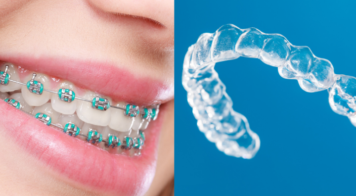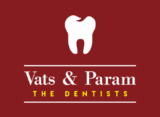Braces & Aligners
Braces and aligners are orthodontic devices that straighten and align teeth. Braces consist of metal or ceramic brackets and wires that are bonded to the teeth. Aligners are clear trays that are custom-made to fit over the teeth. Both apply gentle pressure to move teeth into position. Braces are more effective for complex cases, while aligners are more comfortable and convenient. The choice depends on the patient's specific orthodontic needs and lifestyle. Proper oral hygiene and dental checkups are essential for successful treatment.

There are several circumstances that may lead someone to consider getting braces or aligners. These include:
- Crooked teeth: When teeth are crooked or crowded, braces or aligners may be needed to align them properly.
- Overbite or underbite: When the upper or lower teeth extend too far beyond the opposite set, braces or aligners can help correct the bite.
- Crossbite: When the upper and lower jaws don't meet properly, braces or aligners can help bring them into alignment.
- Jaw problems: Braces or aligners can be used to correct jaw alignment issues that can cause pain, discomfort, or difficulty chewing.
- Aesthetic concerns: Some people may choose to get braces or aligners for cosmetic reasons, to improve the appearance of their teeth and smile.
- Speech problems: Misaligned teeth or jaws can sometimes cause speech difficulties, and braces or aligners can help correct these issues.
Ultimately, the decision to get braces or aligners depends on the individual's specific orthodontic needs and preferences, as well as the recommendations of their orthodontist.
If there's anything you'd like to know more about, just let us know - we're always happy to provide additional information
Fill the details will get back to you shortly...

The length of treatment depends on the complexity of your orthodontic issues, but typically ranges from 6 months to 3 years.
There may be some discomfort or soreness during the initial adjustment period, but it should subside within a few days. Over-the-counter pain relievers can help.
For braces, certain foods should be avoided to prevent damage to the brackets and wires. With aligners, you can remove them to eat, but should still avoid hard, sticky or sugary foods that can damage your teeth.
Orthodontic appointments are typically scheduled every 4-8 weeks, depending on the stage of treatment.
Yes, you can still participate in sports or play musical instruments, but you may need to take some precautions such as wearing a mouthguard for contact sports or being extra careful with your aligners when playing wind instruments.
You should brush your teeth twice a day and floss daily, and avoid sugary or acidic drinks that can cause decay. With braces, you'll need to use special brushes and floss threaders to clean between the brackets and wires, while with aligners, you'll need to brush them before reinserting.
Yes, a retainer is typically needed after treatment to help maintain the new position of your teeth. Your orthodontist will give you instructions on how long and how often to wear your retainer.
After completing orthodontic treatment with braces or aligners, it's important to follow post-treatment care instructions to maintain the results achieved during treatment. Here are some tips for caring for your teeth and mouth after braces or aligners:
- Wear your retainer as directed by your orthodontist. This will help prevent your teeth from shifting back to their original position.
- Brush your teeth twice a day with fluoride toothpaste and floss daily. This will help prevent cavities and gum disease.
- Continue to visit your dentist for regular checkups and cleanings every six months.
- Avoid hard, crunchy, or sticky foods that could damage your teeth or your retainer.
- If you have a permanent retainer, be sure to clean it thoroughly by using a floss threader or interdental brush to remove any food particles or plaque.
- If you have a removable retainer, clean it by using a soft toothbrush and non-abrasive toothpaste, or by soaking it in a retainer cleaning solution.
- If you experience any discomfort or pain after treatment, contact your orthodontist right away.
By following these post-treatment care instructions, you can help ensure that your teeth remain straight and healthy for years to come.

Working Hours
Monday - Saturday : 10:30 AM - 7:00 PM
Thursday: Holiday
Sunday: 10:30 AM - 1:00 PM
Call Us
+91 91081 24151
+91 99001 14151
Mail Us
happytohelp@vatsandparam.com